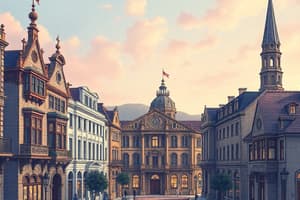Podcast
Questions and Answers
What is the primary aim of planning in land use?
What is the primary aim of planning in land use?
- To ensure all land is developed uniformly
- To minimize the number of greenfield developments
- To increase urban sprawl
- To improve residents' welfare and quality of life (correct)
What characterizes Greenfield Development?
What characterizes Greenfield Development?
- Infill development within existing urban areas
- Redevelopment of contaminated sites
- Repurposing vacant buildings
- Building on previously undeveloped land (correct)
Which principle emphasizes the importance of planning in management functions?
Which principle emphasizes the importance of planning in management functions?
- Primacy of Planning (correct)
- Planning Premises
- Principle of Alternatives
- Contribution to objectives
What type of sites does Brownfield Development focus on?
What type of sites does Brownfield Development focus on?
What is a characteristic effect of the Urban Heat Island phenomenon?
What is a characteristic effect of the Urban Heat Island phenomenon?
What is Infill Development?
What is Infill Development?
What is the primary goal of Urban Planning?
What is the primary goal of Urban Planning?
Which principle of planning involves creating various alternatives for consideration?
Which principle of planning involves creating various alternatives for consideration?
Which professional fields contribute to Urban Planning?
Which professional fields contribute to Urban Planning?
What is the purpose of establishing planning premises?
What is the purpose of establishing planning premises?
Which of the following is a concern of Urban Planning related to aesthetics?
Which of the following is a concern of Urban Planning related to aesthetics?
What skill is essential for Urban Planners when engaging with the community?
What skill is essential for Urban Planners when engaging with the community?
What action might Urban Planners take if a proposed project is found to be detrimental?
What action might Urban Planners take if a proposed project is found to be detrimental?
Why is flexibility important for Urban Planners?
Why is flexibility important for Urban Planners?
What is the primary focus of urban design?
What is the primary focus of urban design?
Which of the following does Urban Planning NOT directly manage?
Which of the following does Urban Planning NOT directly manage?
What role do Urban Planners typically have in community projects?
What role do Urban Planners typically have in community projects?
Which of the following best describes urban revitalization?
Which of the following best describes urban revitalization?
What is a key component of community involvement in urban planning?
What is a key component of community involvement in urban planning?
Which aspect of urban planning focuses on ensuring public safety?
Which aspect of urban planning focuses on ensuring public safety?
What is a significant outcome of effective economic development in urban planning?
What is a significant outcome of effective economic development in urban planning?
What is the role of infrastructure planning in urban areas?
What is the role of infrastructure planning in urban areas?
Which of these does natural resources management prioritize?
Which of these does natural resources management prioritize?
What is a potential solution for urban decay addressed in urban planning?
What is a potential solution for urban decay addressed in urban planning?
What is a key characteristic of the Age of High Mass Consumption?
What is a key characteristic of the Age of High Mass Consumption?
What transformation is attributed to urbanization during economic transitions?
What transformation is attributed to urbanization during economic transitions?
Which of the following is a necessary consideration for urban planners during economic transitions?
Which of the following is a necessary consideration for urban planners during economic transitions?
What does the shift in economic activity imply for land use?
What does the shift in economic activity imply for land use?
What is one objection related to urban planning and economic transition?
What is one objection related to urban planning and economic transition?
What was the main characteristic of Broadacre City proposed by Frank Lloyd Wright?
What was the main characteristic of Broadacre City proposed by Frank Lloyd Wright?
What significant urban design principle did Radiant City by Le Corbusier emphasize?
What significant urban design principle did Radiant City by Le Corbusier emphasize?
During which period did the introduction of organized urban centers focusing on central plazas occur?
During which period did the introduction of organized urban centers focusing on central plazas occur?
Which of the following best describes the urban planning focus during the American Colonial Period?
Which of the following best describes the urban planning focus during the American Colonial Period?
What iconic type of community organization was prevalent during the Pre-Colonial Age in the Philippines?
What iconic type of community organization was prevalent during the Pre-Colonial Age in the Philippines?
What was the overarching aim of the Transect model in urban planning?
What was the overarching aim of the Transect model in urban planning?
What major urban planning philosophy is associated with Le Corbusier’s approach in Radiant City?
What major urban planning philosophy is associated with Le Corbusier’s approach in Radiant City?
Which urban planning concept focused on organizing environments to improve the quality of life for urban dwellers?
Which urban planning concept focused on organizing environments to improve the quality of life for urban dwellers?
Flashcards are hidden until you start studying
Study Notes
Urban Planning
-
Urban Planning is a multifaceted field focused on managing and developing metropolitan areas, encompassing numerous disciplines.
-
Objectives of Urban Planning:
- Creating safe, organized, and enjoyable environments for residents.
- Addressing both new developments and existing urban areas.
- Correcting problems caused by unplanned urban expansion.
-
Concerns of Urban Planning:
- Building Locations
- Zoning
- Urban Aesthetics
- Transportation
- Eliminating run-down areas and preserving nature.
-
Urban Planners perform several functions:
- Identify the best way to meet community infrastructure needs and handle growth.
- Oversee all aspects of planning, including research on economic and environmental impacts.
- Work with developers and communities to transform proposals into reality.
- Recommend rejection of proposals if research indicates detrimental effects.
-
Skills and Qualifications for Urban Planners:
- Education, Training & Certification.
- Flexibility to adapt to changing deadlines and priorities.
- Strong verbal communication to interact with the public, business community, and elected officials.
- Leadership skills to oversee community projects and staff.
- Analytic skills for evaluating policy and influencing land use.
Principles of Planning
-
Contribution to Objectives: Planning is designed to achieve organizational goals.
-
Primacy of Planning: Planning is a fundamental function for all managers.
-
Planning Premises: Planners rely on presumptions and premises to make the planning process effective.
-
Principle of Alternatives: Planning involves developing multiple alternatives and selecting the best option to achieve goals.
Types of Development
-
Greenfield Development: Building on previously undeveloped land, often on city outskirts.
-
Brownfield Development: Redevelopment of previously developed sites that may be contaminated, requiring careful planning.
-
Infill Development: Building on vacant or underutilized land within existing urban areas, also known as urban densification.
Urban Development Phenomena
-
Urban Heat Island: Cities can experience higher temperatures compared to surrounding areas due to factors like heat-absorbing surfaces.
-
Conditional Use Permit: A permit granted for a specific use that may not be allowed under the general zoning regulations, but meet specific conditions.
Urban Revitalization
- Urban Revitalization focuses on rejuvenating areas in decline by:
- Implementing strategies to repair infrastructure.
- Cleaning up pollution.
- Adding public spaces.
- Engaging the community to tailor efforts to their needs.
Economic Development
- Economic Development aims to promote financial prosperity by:
- Attracting businesses to a city.
- Boosting local employment.
- Increasing consumer spending.
- Enhancing aesthetics.
Considerations in Urban Planning
-
Aesthetics: Emphasizes visually pleasing urban environments through architecture, landscaping, and public art.
-
Safety and Security: Design urban spaces to minimize crime and ensure public safety through well-lit streets, secure buildings, and accessible emergency services.
-
Decay and Urban Revitalization: Address urban decay, including slumlords, and implement strategies for reconstruction and renewal.
The History of Urban Planning
-
Pre-Classical Era:*
-
Early civilizations, including Mesopotamia, the Indus Valley, and Egypt, established foundational principles of urban layout and design.
-
Broadacre City (1932):*
-
Designed by architect Frank Lloyd Wright.
-
Proposed a decentralized model where each family would live on an acre or more of land spread over a vast area.
-
Radiant City (1933):*
-
Created by architect Le Corbusier.
-
Focused on creating an ideal urban environment emphasizing efficiency, order, and modern living.
-
The Transect (2000):*
-
Developed by architect Andres Duany.
-
Provides a structured framework for organizing environments while balancing natural, rural, and urban areas.
Urban Planning in the Philippines
-
Pre-Colonial Age:*
-
Communities were primarily organized into small villages (“barangays”) situated along coastlines, rivers, and natural resources.
-
Spanish Regime:*
-
This era saw the rise of organized urban centers, focusing on the central “plaza” complex and a grid pattern for streets.
-
American Colonial Period:*
-
American influence brought modern urban planning, emphasizing public health, sanitation, and aesthetics.
Rostow's Stages of Growth
-
Traditional Society: An agricultural-based economy with low levels of technology and limited scientific perspectives.
-
Preconditions to Takeoff: Shifts toward more productive sectors like industry and services, leading to overall economic efficiency.
-
Takeoff: This marks the beginning of rapid economic growth, driven by new industries and increased productivity.
-
Drive to Maturity: The economy further diversifies, expands international trade, and invests in technology and infrastructure.
-
Age of High Mass Consumption: The economy thrives in a capitalist system with mass production and consumerism.
Objections to Rostow's Stages of Growth
-
Oversimplification: Critics argue that the stages oversimplify complex economic realities and disregard diverse local contexts.
-
Eurocentrism: The model is rooted in a Western perspective and may not accurately represent the development experiences of other regions.
-
Excessive Focus on Industrialization: The model emphasizes industrialization as the primary driver of economic growth, neglecting the importance of other sectors and sustainable practices.
-
Assumes Homogenous Development: The model assumes that all countries follow a linear path towards development, neglecting the diverse and often non-linear trajectories of different economies.
-
Neglect of Environmental and Sustainable Concerns: The model overlooks the environmental costs of economic growth and fails to address the importance of sustainability.
Studying That Suits You
Use AI to generate personalized quizzes and flashcards to suit your learning preferences.




